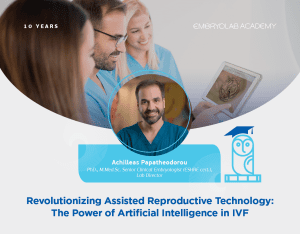
By Achilleas Papatheodorou, PhD., M.Med.Sc., Senior Clinical Embryologist, ESHRE certified, Lab Director
The realm of Assisted Reproductive Technology (ART) has seen remarkable advancements in recent years, offering renewed hope to individuals and couples striving to achieve successful pregnancies. One such breakthrough is the integration of Artificial Intelligence (AI) into the In Vitro Fertilization (IVF) process. AI technology has emerged as a game-changer in improving the efficiency and clinical outcomes of IVF treatments, addressing longstanding challenges that have plagued the field for decades.
The Role of AI in IVF
At its core, the objective of IVF is to transfer an euploid (chromosomally normal) embryo to the uterus, increasing the chances of a successful live birth. Traditionally, embryologists have relied on manual, visual assessments to evaluate embryos for transfer and predict their potential to lead to a successful pregnancy. However, this method has proven to be inherently subjective, leading to variability in assessments across different laboratories and even among embryologists within the same lab.
In the pursuit of optimizing the IVF process and enhancing success rates, the integration of AI technology has emerged as a promising solution. AI systems can offer standardized, objective, and highly accurate evaluations, reducing the subjectivity and variability associated with traditional manual embryo grading.
Challenges of Manual Embryo Evaluation
Embryo evaluation based on morphology, a practice entrenched in the history of ART, has long been the gold standard. Embryologists assess specific morphological features at key developmental stages and categorize embryos according to predefined criteria. Two commonly used criteria are the Gardner and ASEBIR standards, both of which are based on blastocyst expansion, inner cell mass quality, and trophectoderm quality.
However, as embryology laboratories expanded and evolved, an inherent problem became evident – the substantial variability in embryo assessments. Studies have demonstrated limited agreement among embryologists when ranking embryos based on morphology, leading to challenges in decision-making and impacting the overall success rates of IVF.
One study exemplifies this phenomenon. Researchers assessed the inter-laboratory concordance among participants in classifying embryos using three methods: conventional manual assessment without time-lapse, morphology assessment utilizing the embryoscope, and morphology assessment using the primo vision time-lapse system. The results showed that the level of inter-laboratory consensus was, at best, moderate, with none demonstrating substantial agreement.
Beyond the issue of limited inter- and intra-observer agreement, relying solely on conventional embryo grading for manual evaluation can lead to various adverse outcomes, including reduced laboratory efficiency, increased risk of errors during manual data transfer, elevated levels of occupational stress and fatigue among embryologists, and complications in inter-laboratory and inter-clinic communication. Moreover, it often necessitates unnecessary repetition of workflows.
The Emergence of AI in IVF: Embryolab’s experience
In response to these challenges, Embryolab introduced a groundbreaking AI platform known as EMA which was developed by AiVF, an Israeli AI startup company. EMA is designed to monitor embryo development using time-lapse videos, providing embryologists with invaluable insights into embryo quality and potential for clinical pregnancy.
EMA’s embryo scoring model is a testament to the power of machine learning (ML), developed through the analysis of over 200,000 embryos from seven clinics, each associated with its own set of clinical variables. The algorithm assigns a continuous score to each embryo on a scale from 1 to 9.9, reflecting both its quality and the likelihood of achieving a clinical pregnancy.
EMA’s capabilities become especially evident on day 5, when it ranks embryos according to their scores, allowing embryologists to easily identify the most promising candidates for transfer. Moreover, EMA provides embryologists with the option to annotate each embryo and make decisions regarding transfer, freezing, or discarding.
Embryolab’s Research and Findings
In an effort to validate the efficacy of EMA, Embryolab conducted a comprehensive study involving 526 embryos from 49 IVF cycles, all of which had produced at least two good-quality blastocysts. The study aimed to compare the time required for embryo annotation, scoring, and decision-making through traditional manual methods and EMA.
The results were nothing short of revolutionary:
– Traditional grading, annotation, and recording of embryos required an average of 200 seconds per embryo. In stark contrast, EMA provided instant results, reducing the time required to a mere 0 seconds.
– Clinical and embryological decisions for a cohort of 10 embryos took almost 300 seconds in the conventional mode. With EMA, this process was streamlined to less than 60 seconds, leading to a remarkable reduction in workflow time by 97.8%.
Furthermore, the study underscored EMA’s exceptional ability to differentiate between embryo grades and its strong correlation with the percentage of embryos resulting in successful pregnancies. These findings validated the platform’s ability to quantitatively assess the likelihood of achieving clinical pregnancy.
Clinical Outcomes and Future Prospects
Buoyed by these promising results, Embryolab initiated a clinical trial, a prospective, randomized controlled study aimed at evaluating the clinical outcomes of embryo transfers. The study compared the results of embryos selected by embryologists with those chosen using EMA. The preliminary findings were highly encouraging:
– Group A, consisting of 26 patients randomized to embryo evaluation with conventional morphology (embryologist evaluations), achieved a clinical pregnancy rate of 42%.
– Group B, comprising 21 patients randomized to embryo evaluation with EMA, achieved a clinical pregnancy rate of 57%. Importantly, both groups had embryos of similar quality.
– EMA demonstrated clinical utility similar to embryologists’ visual assessment in predicting pregnancy success, providing a relative percent improvement of 35% in assessing the likelihood of clinical pregnancy.
These early results suggest that EMA has the potential to significantly enhance the IVF process, ultimately leading to higher success rates and increased patient satisfaction. However, it’s important to note that further research is required to demonstrate statistical significance, which will become more evident as the sample size in the ongoing study expands.
In conclusion, the conventional method of embryo evaluation in IVF poses significant challenges, from limited consistency among embryologists to reduced laboratory efficiency. The integration of AI technology, as exemplified by EMA, offers a path to streamline and optimize IVF laboratory workflows, enhancing efficiency, efficacy, and the quality of care provided to patients.
Conclusion
The integration of AI technology into the world of In Vitro Fertilization has ushered in a new era of efficiency, accuracy, and hope. Embryolab’s groundbreaking work with EMA highlights the potential of AI in addressing longstanding challenges and improving the outcomes of fertility treatments.
The power of AI lies in its ability to standardize evaluations, eliminate subjectivity, improve efficiency, and provide highly accurate predictions. As AI continues to evolve and become more deeply integrated into IVF, the field is poised for a future marked by higher success rates, shorter treatment cycles, and a more data-driven approach to fertility care.
However, as with any transformative technology, AI also brings challenges and ethical considerations that must be addressed to ensure responsible and equitable use. With the right regulatory frameworks, patient education, and oversight, the promise of AI in IVF can be harnessed to help more people realize their dreams of parenthood.





